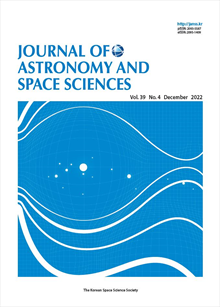간행물
Journal of Astronomy and Space Sciences KCI 등재 SCOPUS

- 발행기관 한국우주과학회
- 자료유형 학술지
- 간기 계간
- ISSN 2093-5587 (Print)2093-1409 (Online)
- 수록기간 1984 ~ 2022
- 주제분류 자연과학 > 천문학 자연과학 분류의 다른 간행물
- 십진분류KDC 443DDC 520
권호리스트/논문검색
제37권 4호 (2020년 12월) 4건
Research Paper
1.
2020.12
서비스 종료(열람 제한)
A CubeSat platform has become a popular choice due to inexpensive commercial off-the-shelf (COTS) components and low launch cost. However, it requires more power-efficient and higher-data rate downlink capability for space applications related to remote sensing. In addition, the platform is limited by the size, weight and power (SWaP) constraints as well as the regulatory issue of licensing the radio frequency (RF) spectrum. The requirements and limitations have put optical communications on promising alternatives to RF communications for a CubeSat platform, owing to the power efficiency and high data rate as well as the license free spectrum. In this study, we analyzed the performance of optical downlink communications compatible with CubeSat platforms in terms of data rate, bit error rate (BER) and outage probability. Mathematical models of BER and outage probability were derived based on not only the log-normal model of atmospheric turbulence but also a transmitter with a finite extinction ratio. Given the fixed slot width, the optimal guard time and modulation orders were chosen to achieve the target data rate. And the two performance metrics, BER and outage data rate, were analyzed and discussed with respect to beam divergence angle, scintillation index and zenith angle.
2.
2020.12
서비스 종료(열람 제한)
There has been increasing necessity of more precise prediction and measurements of aviation radiation in Korea. For our air crew and passengers’ radiation safety, we develop our own radiation prediction model of KREAM. In this paper, we validate the KREAM model based on comparison with Liulin observations. During early three months of this year, we perform total 25 experiments to measure aviation radiation exposure using Liulin-6K in commercial flights. We found that KREAM’s result is very well consistent with Liulin observation in general. NAIRAS shows mostly higher results than Liulin observation, while CARI-6M shows generally lower results than the observations. The percent error of KREAM compared with Liulin observation is 10.95%. In contrast, the error for NAIRAS is 43.38% and 22.03% for CARI-6M. We found that the increase of the altitude might cause sudden increase in radiation exposure, especially for the polar route. As more comprehensive and complete analysis is required to validate KREAM’s reliability to use for the public service, we plan to expand these radiation measurements with Liulin and Tissue Equivalent Proportional Counter (TEPC) in the near future.
Technical Paper
3.
2020.12
서비스 종료(열람 제한)
Young-Rok Kim, Young-Joo Song, Jae-ik Park, Donghun Lee, Jonghee Bae, SeungBum Hong, Dae-Kwan Kim, Sang-Ryool Lee
The ground tracking support is a critical factor for the navigation performance of spacecraft orbiting around the Moon. Because of the tracking limit of antennas, only a small number of facilities can support lunar missions. Therefore, case studies for various ground tracking support conditions are needed for lunar missions on the stage of preliminary mission analysis. This study analyzes the ground supporting condition effect on orbit determination (OD) of Korea Pathfinder Lunar Orbiter (KPLO) in the lunar orbit. For the assumption of ground support conditions, daily tracking frequency, cut-off angle for low elevation, tracking measurement accuracy, and tracking failure situations were considered. Two antennas of deep space network (DSN) and Korea Deep Space Antenna (KDSA) are utilized for various tracking conditions configuration. For the investigation of the daily tracking frequency effect, three cases (full support, DSN 4 pass/day and KDSA 4 pass/day, and DSN 2 pass/day and KDSA 2 pass/day) are prepared. For the elevation cut-off angle effect, two situations, which are 5 deg and 10 deg, are assumed. Three cases (0%, 30%, and 50% of degradation) were considered for the tracking measurement accuracy effect. Three cases such as no missing, 1-day KDSA missing, and 2-day KDSA missing are assumed for tracking failure effect. For OD, a sequential estimation algorithm was used, and for the OD performance evaluation, position uncertainty, position differences between true and estimated orbits, and orbit overlap precision according to various ground supporting conditions were investigated. Orbit prediction accuracy variations due to ground tracking conditions were also demonstrated. This study provides a guideline for selecting ground tracking support levels and preparing a backup plan for the KPLO lunar mission phase.
4.
2020.12
서비스 종료(열람 제한)
We develop the tissue-equivalent proportional counter (TEPC) type’s space radiation dosimeter to measure in-situ aviation radiation. That was originally developed as a payload of small satellite in the low-earth orbit. This dosimeter is based on a TEPC. It is made of an A-150 tissue-equivalent plastic shell of an internal diameter of 6 cm and a thickness of 0.3 cm. TEPC is filled with pure propane at 13.9 torrs to simulate a cell diameter of 2 μm. And the associated portable and low power electronics are also implemented. The verification experiments have been performed by the calibration experiments at ground level and compared with Liulin observation at aircraft altitude during the flight between Incheon airport (ICN) and John F. Kennedy airport (JFK). We found that the TEPC dosimeter can be used as a monitor for space radiation dosimeter at aviation altitude based on the verification with Liulin observation.

